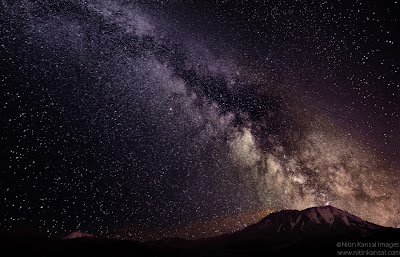 |
| Milky Way and Light Painting at Delicate Arch, Arches National Park, Utah |
Hello Friends!
As some of you already know, This weekend is time for Meteor shower. This will be very interesting photographic opportunity too. As Skies are clear during Mid August here in PNW, It's very easy to enjoy this Astronomical event.
To watch these meteor shower you do not need any fancy telescope or a device. You can see them from direct eyes without any harmful effect. To see these meteor, you should be away from light pollution from city lights. As a rule of thumb, I always found around 30-45 minutes away from City ( ~40 Miles) decent to watch stars and milky way. The same rule applies for watching Perseid Meteor showers too.
Here are the tips which i found very helpful in Night photography like Star Trails, Milky way and Meteors.
Plan for a Place to shoot
Planning for a place is very important. To get nice photographs you need some interesting foreground along with interesting elements like Stars, Meteor & Milky way in background. Few of places i like for Night photography are:
a) Picture Lake - Mt Baker
b) Reflection Lake - Mt Rainier
c) Ross / Diablo Lake - Cascades
d) Rattlesnake Ledge ( only 45 mins drive from Seattle)
All of these places are easy to access and does not require hiking or backpacking.
Arrive Early - Possibly before Sunset
This will give you enough time for scouting around the area. During night, It's difficult to capture details in foreground like flowers, mountain etc. If you arrive early, you pick your spot and take some pictures before it's completely dark and later takes shots of sky and stars. During Post, you can blend images in your favorite photo editor.
Stable Platform - Tripod and Remote Shutter Release is a must!
Stable Platform is a must to get sharp pictures in Night. When shooting Milkyway, Stars and Meteors, generally exposures are ~30 Sec. It's almost impossible to get tack sharp pictures w/o stable platform. A good quality tripod and remote shutter release should be first thing you keep in your gear bag before you head out for shooting!
Camera Settings - ISO, Aperture and Shutter Speed
If you have a fancy full frame camera, you are in luck as Full frame camera have bigger sensor and results in better IQ at higher ISOs. But now a days, Digital sensors have improved
and you can get decent IQ from entry level SLR too. Noise introduced due to High ISO is easy to fix during post processing.
- If your Camera and Lens allow manual focusing than, Set your focus to infinity and set to manual focusing mode ( M / MF on some lenses )
- To prevent star movements in your images, your shutter speed should be lower than 30 sec. Ideally around 20-25 Secs.
- You need preferably wide angle lens to include more sky in your shots. Open your lens as wide as you can ( low F number like F1.8 or F2.8 ).
- Last but not least, Your ISO needs to be in between 1600 - 4000 to get good exposure. I always start with ISO 1600 and take some sample shots and adjust ISO accordingly.
Memory Cards , Batteries and Warm gloves/Hand warmer
Carry lot of extra memory cards as you would be continuously shooting. You do not realize that you need more memory cards at night than during day because you are continuously taking photos!! Avoid large memory cards like 64GB or above. I always prefer 32GB or 16GB. This prevents you from trouble if your memory card fails as your shots are hedge among different memory cards.
Batteries drain much faster during Night. Long exposure and colder nights helps in draining batteries much faster than you would expect. I would suggest keeping 2 extra batteries if you plan to shoot for 2-3 hours or more.
Condensation is another problem in Night photography. Even though it might be 60s outside but your lens could be colder and can condense very soon. To avoid this, I always keep hand warmers and some rubber bands with me. They are cheap solution to keep your lens warm during night time :)
Don't forget to keep Flash lights, Munching bars and Mosquito repellent with you! You will be glad to carry those :)
If you found this post useful, please share it among your friends and Don't forget to share your photos here. I would love to see them!
Happy Shooting! NK






